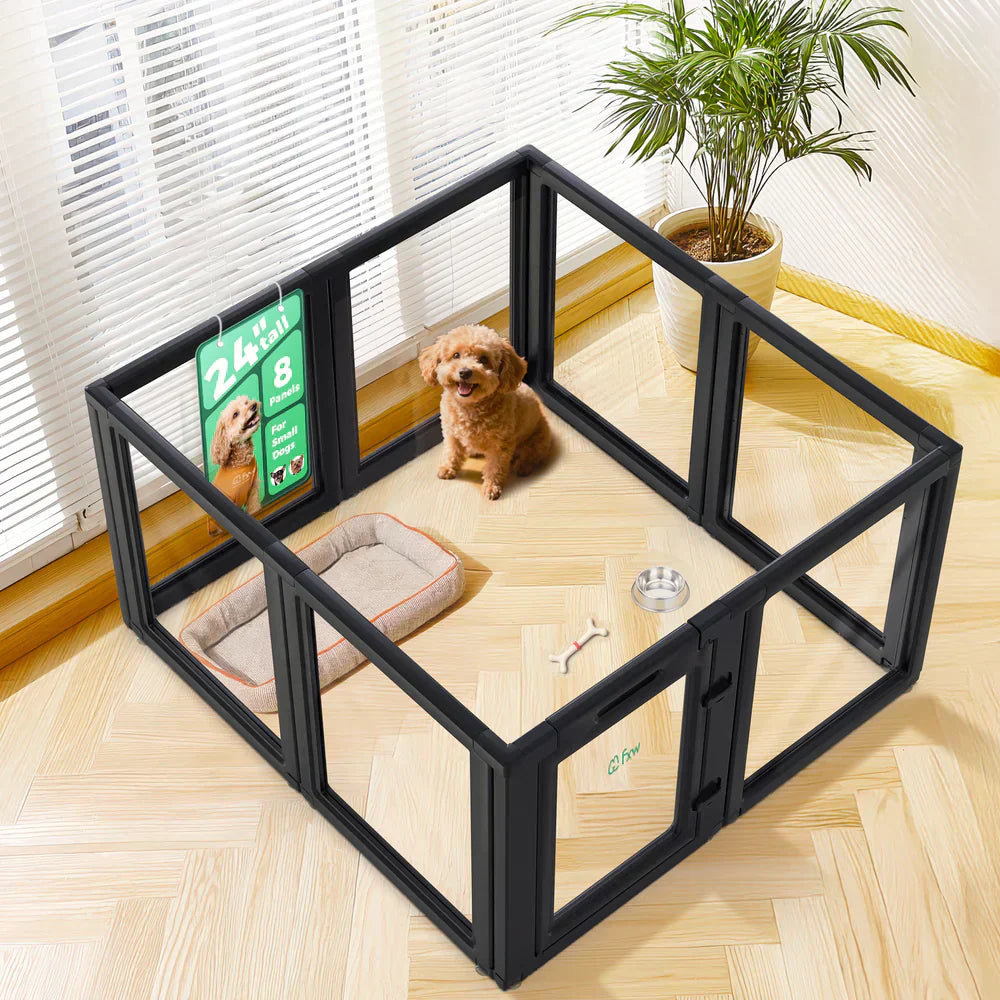Understanding the Puppy Mind
Puppies are curious, affectionate, and full of energy. Everything they do is guided by exploration. However, this curiosity can quickly become overwhelming when they have no structure or routine.
Puppies need a mix of freedom and boundaries to build confidence. Without clear limits, they can become anxious or overly dependent on their owners.
A playpen helps establish those limits in a gentle and positive way. It becomes a personal space where your puppy can play, rest, and observe without stress.
Why Boundaries Build Better Behavior
Boundaries teach puppies emotional regulation. When they learn that calm behavior earns rewards and attention, they begin to make better choices on their own.
Encouraging Independence
A playpen helps puppies spend short periods away from constant human attention. This independence reduces separation anxiety and builds trust. The AKC’s guide on leaving your puppy alone explains that structured alone time allows dogs to relax and self-soothe.
Supporting Calm Energy

When puppies have too much space or freedom, they can become overstimulated. The playpen acts as a natural cue to slow down and rest. Adding a soft dog bed or calming toy reinforces that sense of security.
Creating Consistent Rules
Consistency helps puppies understand what is allowed and what is not. There're study states that consistency and positive reinforcement are key to long-term good behavior.
Boundaries are not about control; they are about clarity. When your puppy knows what to expect, they feel safe and less reactive.
The Role of Playpens in Puppy Development
Many dog owners see playpens as a tool for convenience, but they actually play a major role in early training. A well-designed playpen provides freedom within limits, allowing puppies to explore without danger.
Safe Exploration
Playpens offer a contained environment where puppies can move freely while staying protected from hazards like wires or furniture. For outdoor use, sturdy designs such as the FXW Outdoor Playpen keep your dog secure while letting them enjoy nature.
A Positive Learning Space
When you place treats, toys, and a cozy blanket inside, the pen becomes a place of comfort rather than confinement. The AKC crate training guide notes that dogs learn to associate such spaces with relaxation and safety.
A Support for Busy Seasons
During the holidays, homes become noisy and full of guests. A playpen can give your puppy a calm spot away from excitement. Adding soft lighting, holiday scents, and their favorite FXW dog bed can help them feel peaceful even in the middle of family gatherings.
How to Introduce Boundaries the Right Way
The first experience with boundaries sets the tone for your puppy’s learning. Here are a few ways to make it positive.
-
Start by letting your puppy explore the playpen on their own.
-
Offer treats and praise when they enter willingly.
-
Keep the first sessions short, just five to ten minutes.
-
Gradually increase the time as your puppy relaxes inside.
-
Always associate the pen with positive experiences.
The AKC recommends keeping these early sessions calm and rewarding, so the puppy sees the pen as a safe haven, not a place of isolation.
Building Trust Through Routine
Boundaries only work when they are paired with trust. Keeping a consistent routine helps your puppy feel secure. Feed them, play with them, and let them rest at predictable times.
Structure helps reduce anxiety and improves focus. A daily routine that includes playpen time encourages patience and emotional balance.
A comfortable setup matters too. Add soft textures like blankets, keep the temperature cozy, and make sure your puppy always has access to water. You can even place the pen near the family area so your dog still feels included.
The Emotional Benefits of Boundaries

Boundaries might sound strict, but they actually make puppies feel loved. Clear expectations help dogs understand their world. They learn to relax because they know what to expect from you.
When a puppy feels secure in their playpen, they start to view it as their personal sanctuary. That emotional safety supports healthy social behavior, better sleep, and stronger bonding with their owners.
If your goal is to raise a calm and confident dog, the journey starts with gentle structure.
For dog parents who want a setup that feels natural and stable, explore the FXW Playpen Collection. It offers flexible configurations and durable panels for both indoor and outdoor use, giving your puppy a safe space they can truly call their own.
FAQ
1. Are playpens really necessary for puppies?
Yes. Playpens provide a safe environment that prevents accidents and encourages independence.
2. How long should a puppy stay in a playpen?
Start with short periods of five to fifteen minutes and increase gradually. Puppies should never be confined for several hours without breaks.
3. Should I use a playpen or a crate?
Both can be effective. A playpen offers more space, while a crate creates a smaller, den-like setting. Many trainers suggest using both during different parts of the day.
4. How do I make my puppy love the playpen?
Add toys, soft bedding, and treats. Never use the playpen for punishment. Make it a place for relaxation and comfort.
5. What if my puppy cries in the pen?
Stay patient and wait until they are calm before giving attention. According to the AKC, responding during crying reinforces anxious behavior.


Share:
The Ultimate Guide to Escape-Proof Puppy Playpens
How to Create a Cozy Christmas Corner for Your Dog | Holiday Comfort & Safety Tips